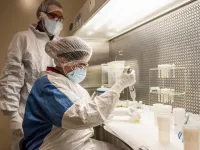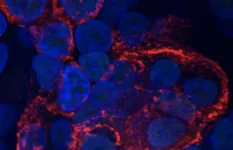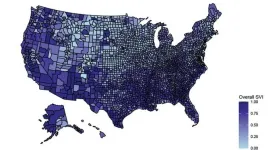COVID unemployment assistance puts food on the table: BU study
2021-01-29
(Press-News.org) Another wave of COVID-19 is putting millions out of work, while tens of millions more remain unemployed, and Congress debates aid.
Now, a new Boston University School of Public Health (BUSPH) study shows that unemployment help directly translates to people being able to put food on the table.
The CARES Act--passed in March of 2020-- expanded unemployment insurance coverage, amount, and duration.
Published in JAMA Network Open, the study finds that receiving unemployment insurance cuts a person's risk of food insecurity by a third, and halves the likelihood of needing to eat less because of financial constraints. And receiving more coverage, such as the weekly $600 supplement included in CARES until last July, means an even bigger reduction in the risk of going hungry.
"There has long been a need to improve the proportion of people covered, the duration of coverage, and the amount of coverage in our unemployment insurance system. This paper speaks to the critical role that unemployment insurance can play in preventing people from facing food insecurity during a crisis," says study lead author Dr. Julia Raifman, assistant professor of health law, policy & management at BUSPH.
Raifman and colleagues used data from the Understanding Coronavirus in America study, looking at a sample of 2,319 people who had household incomes less than $75,000 and had been employed in February. By the end of July, 1,119 people (nearly half) had experienced unemployment.
Of those who lost their jobs, 415 reported food insecurity and 437 reported that they sometimes ate less because of financial constraints.
The researchers found that receiving unemployment insurance was associated with a 35.0% relative decline in a person's risk of food insecurity, and a 47.8% relative decline in the likelihood of having to eat less. Receiving larger amounts of unemployment insurance and/or the weekly $600 CARES supplement came with even more substantial declines in food insecurity and having to eating less.
The researchers also identified major disparities in who is facing food insecurity among those who have lost their jobs during COVID: 69.2% of Indigenous participants in the study reported food insecurity, as did 52.5% of Hispanic participants, 42.2% of Black participants, 40.3% of Asian participants, and 26.9% of non-Hispanic white participants.
They also found that 46.1% of households with kids faced food insecurity, compared to 32.8% of households without kids.
"It is heartbreaking that families with children are even more likely to face food insecurity," Raifman says. "The recent Booker/Pressley policy proposal to provide direct payments to children's families could make a big difference for their food security and short- and long-term health."
INFORMATION:
About the Boston University School of Public Health
Founded in 1976, the Boston University School of Public Health is one of the top five ranked private schools of public health in the world. It offers master's- and doctoral-level education in public health. The faculty in six departments conduct policy-changing public health research around the world, with the mission of improving the health of populations--especially the disadvantaged, underserved, and vulnerable--locally and globally.
ELSE PRESS RELEASES FROM THIS DATE:
2021-01-29
RICHLAND, Wash.?Unless radon gas is discovered in a home inspection, most people remain blissfully unaware that rocks like granite, metal ores, and some soils contain naturally occurring sources of radiation. In most cases, low levels of radiation are not a health concern. But some scientists and engineers are concerned about even trace levels of radiation, which can wreak havoc on sensitive equipment. The semiconductor industry, for instance, spends billions each year to source and "scrub" ultra-trace levels of radioactive materials from microchips, transistors and sensitive sensors.
Now chemists at the U.S. Department of Energy's Pacific Northwest National Laboratory have developed ...
2021-01-29
What if scientists knew exactly what impact the SARS-CoV-2 virus had inside our lung cells, within the first few hours of being infected? Could they use that information to find drugs that would disrupt the virus' replication process before it ever gets fully underway? The discovery that several existing FDA-approved drugs--including some originally designed to fight cancer--can stop coronavirus in its tracks indicates the answer is a resounding yes.
A team of Boston University researchers--hailing from BU's National Emerging Infectious Diseases Laboratories ...
2021-01-29
Philadelphia, January 29, 2021--Researchers at Children's Hospital of Philadelphia (CHOP) have developed a gene therapy vector for blood disorders like sickle cell disease and beta-thalassemia that is potentially safer and more effective than those currently used in gene therapy trials for those conditions. The vector, an engineered vehicle for delivering functional copies of the hemoglobin gene to correct a genetic abnormality, leads to the production of more hemoglobin with a lower dose, minimizing the risk of toxic side effects.
The findings were published today in Molecular Therapy.
"These results have many potential benefits for the successful treatment of patients ...
2021-01-29
PITTSBURGH, Jan. 29, 2021 - A study led by UPMC Children's Hospital of Pittsburgh and the University of Pittsburgh School of Medicine shows that Black children are 18% less likely to get imaging tests as part of their emergency department visit compared to White children. Hispanic children are 13% less likely to have imaging done than Whites.
The researchers suggest that this disparity results from overuse in White children, though underuse in minority children probably plays a part as well. The root cause likely stems from both patient preferences and implicit bias among providers.
"Something else is going on here that's beyond the clinical, that's beyond the diagnoses," said study lead author Jennifer Marin, M.D., M.Sc., associate ...
2021-01-29
In just one year, COVID-19 has killed more than 400,000 Americans, and infected more than 24 million others. But a new study shows just how unevenly those deaths and cases have played out across the country.
It finds that the more disadvantaged a county's population was before the pandemic, the higher the toll of coronavirus last spring and summer.
That level of disadvantage, measured on a standard scale called the Social Vulnerability Index (SVI), tracked closely with the number of cases and deaths per 100,000 residents in each county, according to the new University of Michigan study.
The ten-point SVI score combines many measures of the social disadvantage of a county's population, with higher scores meaning greater disadvantage. For every ...
2021-01-29
What The Study Did: Maternally derived antibodies are a key element of neonatal immunity. This study examined the association between maternal and neonatal SARS-CoV-2-specific antibody concentrations because understanding the dynamics of maternal antibody responses to SARS-CoV-2 infection during pregnancy and subsequent transplacental antibody transfer can inform neonatal management as well as maternal vaccination strategies.
Authors: Scott E. Hensley, Ph.D., of the University of Pennsylvania in Philadelphia, and Karen M. Puopolo, M.D., Ph.D., of the Children's Hospital of Philadelphia, are the corresponding authors.
To ...
2021-01-29
What The Study Did: Researchers investigated the association between county-level social risk factors and COVID-19 cases and deaths, as well as weekly changes in cumulative cases and mortality, using publicly available data sets as of July 29, 2020.
Authors: Renuka Tipirneni, M.D., M.Sc., of the University of Michigan in Ann Arbor, is th corresponding author.
To access the embargoed study: Visit our For The Media website at this link https://media.jamanetwork.com/
(doi:10.1001/jamanetworkopen.2020.36462)
Editor's Note: The article includes conflict of interest and funding/support disclosures. Please see the article ...
2021-01-29
What The Study Did: This study investigated how unemployment insurance and a $600 per week federal supplement to unemployment insurance were associated with food insecurity among people in low- and middle-income households who lost jobs during the COVID-19 pandemic.
Authors: Julia Raifman, Sc.D., of the Boston University School of Public Health, is the corresponding author.
To access the embargoed study: Visit our For The Media website at this link https://media.jamanetwork.com/
(doi:10.1001/jamanetworkopen.2020.35884)
Editor's Note: The article includes conflict of interest and funding/support disclosures. Please see the article for additional information, including other authors, author contributions and affiliations, conflict ...
2021-01-29
What The Study Did: Researchers examined if the use of diagnostic imaging for children receiving care in pediatric emergency departments in the United States differs by race and ethnicity.
Authors: Jennifer R. Marin, M.D., M.Sc., of the University of Pittsburgh School of Medicine, is the corresponding author.
To access the embargoed study: Visit our For The Media website at this link https://media.jamanetwork.com/
(doi:10.1001/jamanetworkopen.2020.33710)
Editor's Note: The article includes conflict of interest disclosures. Please see the article for additional information, including other authors, author contributions and affiliations, conflict of interest and financial disclosures, ...
2021-01-29
Researchers at the University of Arizona are developing a COVID-19 testing method that uses a smartphone microscope to analyze saliva samples and deliver results in about 10 minutes.
The UArizona research team, led by biomedical engineering professor Jeong-Yeol Yoon, aims to combine the speed of existing nasal swab antigen tests with the high accuracy of nasal swab PCR, or polymerase chain reaction, tests. The researchers are adapting an inexpensive method that they originally created to detect norovirus - the microbe famous for spreading on cruise ships - using a smartphone microscope.
They plan to use the method in conjunction with a saline swish-gargle test developed by Michael Worobey, ...
LAST 30 PRESS RELEASES:
[Press-News.org] COVID unemployment assistance puts food on the table: BU study




